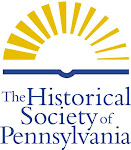
This survey illustrates the plantation's layout over the 918 acres that it occupied. Some of the details provided include the locations of tobacco houses and "negroe quarters." The plantation's location was ideal for transporting crops by boat, as it was situated along Duck Creek, which offered access to the Atlantic Ocean. This land is now designated as the Bombay Hook National Wildlife Refuge.
The papers in this series of the collection are rich with details about farming and animal husbandry, and offer an in-depth view of how the Chew family managed the plantation and the overseers and slaves who produced salable goods there. Benjamin Chew employed several overseers for Whitehall over the course of its operation. George Ford was overseer from approximately 1789-1797, and Joseph Porter succeeded him from 1798-1803. Their letters provide extensive information about life on the plantation--from the impact of weather upon the crops to the birthing and slaughter of animals on the farm. They discuss the slaves, who they often refer to as simply "the people", and their need of clothing and sustenance. Benjamin Chew appears to be pretty hands-off in terms of the day to day workings of Whitehall, and there are some letters that suggest that he may have been neglectful of his workers. George Ford often writes asking for supplies. In one letter, he pleads with Benjamin Chew to send linen for the slaves' clothes, as "the Boys are so naked I Cant git much work out of them..." [April 26 1795].



In another letter, Ford writes that he would have sent Chew another letter, except that he was "down the Creek after Mr Samuel Chew negors that runway from him..." [August 26 1796]. He also updates Benjamin Chew about the state of the stock at Whitehall: "the wheat that was left in the Barn I Sould for two dollars a bus marsh hay we have got about 30 stacks the sesson has been very much a gainst us or we Cold have got more our Corn is very good the back birds has bin very bad on it...."

There are letters in which Ford pleads with Benjamin Chew to come to the plantation to punish various slaves who attacked him, but equally interesting, in my opinion, are the letters that report that not much is getting done because the slaves are sick, lazy, indolent, or are receiving visitors. In a letter from August 3, 1797, Ford writes of his frustration that "the people are so slow and indlent about ther work that I have no comfort with them and some of them are solate home from ther wifes that they lose two ours time in the morning and that three or four times a weak and as for the women they are not worth ther vitles for what work they do. . . Rachel is hear amust every night in the weak and her husban which is free and bears avery bad name...."


These letters shed light on the practice of slavery, which was far more complicated than popular conceptions suggest. There were relationships between free blacks and slaves, and some of the account records describe agreements and negotiations between the Chews and free blacks who purchased the freedom of their family members.
There have been moments during the processing of this collection when I have thrown up my hands in frustration and asked "why did they have to save every scrap of paper?!", but when I look through the materials related to Whitehall, I am grateful that the Chew family preserved their history so religiously. These documents are a gift to our understanding of our past, and I am quite certain that the richness in these boxes will move people in many ways--intellectually, and emotionally. I'll leave off with just one more striking image that made the lists of slaves at Whitehall come alive for me. These two documents are measurements for the slaves' shoes, which illustrate the size of each person's foot with hash marks along a line.


These letters shed light on the practice of slavery, which was far more complicated than popular conceptions suggest. There were relationships between free blacks and slaves, and some of the account records describe agreements and negotiations between the Chews and free blacks who purchased the freedom of their family members.
There have been moments during the processing of this collection when I have thrown up my hands in frustration and asked "why did they have to save every scrap of paper?!", but when I look through the materials related to Whitehall, I am grateful that the Chew family preserved their history so religiously. These documents are a gift to our understanding of our past, and I am quite certain that the richness in these boxes will move people in many ways--intellectually, and emotionally. I'll leave off with just one more striking image that made the lists of slaves at Whitehall come alive for me. These two documents are measurements for the slaves' shoes, which illustrate the size of each person's foot with hash marks along a line.


No comments:
Post a Comment